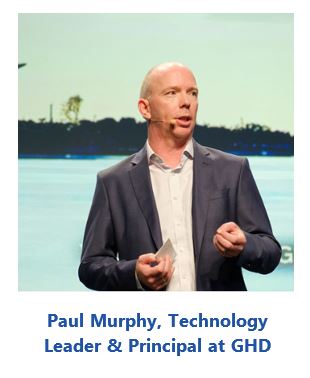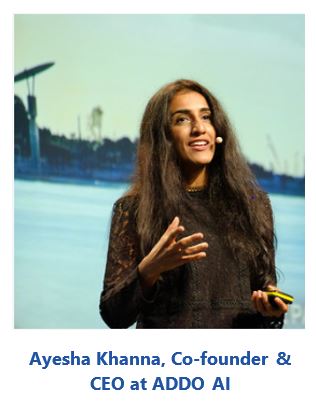Summary
At Bentley Systems’ Year in Infrastructure (YII 2019) Conference in Singapore, the keynote address by CEO Greg Bentley provided a company update and highlighted projects from the 2019 YII nominees that exemplify  advancements that go beyond BIM (building information modeling) to digital twins. He suggested a roadmap of non-disruptive steps to help make infrastructure engineering digital twins a key business benefit of every organization’s “going digital” strategy. Mr. Bentley’s presentation, streamed live to people all over the world, spelled out the company’s strategies and collaborative efforts to accelerate the digital journey.
advancements that go beyond BIM (building information modeling) to digital twins. He suggested a roadmap of non-disruptive steps to help make infrastructure engineering digital twins a key business benefit of every organization’s “going digital” strategy. Mr. Bentley’s presentation, streamed live to people all over the world, spelled out the company’s strategies and collaborative efforts to accelerate the digital journey.
According to Mr. Bentley, “We’ll always be talking about going digital, not a digital transformation that we’ll go through one time and have it behind us. We’ll always be connecting, further automating and improving digital workflows.”
Sada Iyer, Vice President Projects & Engineering, Shell; Paul Murphy, Technology Leader and Principal, GHD; and Ayesha Khanna, Co-founder and CEO, ADDO AI all joined Mr. Bentley on stage. They provided the all-important user and supplier perspectives, which corroborate a company’s claims and helps others gain insights into new technologies that could benefit them.
Key takeaways:
- Digitalization reduces costs and rework
- Digital twins provide evergreen visibility
- 4D digital twins add the dimension of time
Understanding the 4D Digital Twins Perspective
 As Mr. Bentley explained, over its 35 years in business, the company has progressed from 2D, to geospatial representations, to 3D modeling in BIM, and now to 4D digital twins. Until now, the company has been developing high-value software deliverables, but for a static and often dated purpose. In contrast, digital twins enable the value of the deliverables to endure through the lifecycle to provide evergreen visibility, synchronize changes over time, and open up “dark” engineering data for immersive visualization and visibility of analytics. The latter includes analyses over time, which is the fourth dimension (4D). Advancing BIM and GIS as part of a 4D digital environment increases the value of engineers’ work and the information created, and adds more value without having to restart workflows, he said.
As Mr. Bentley explained, over its 35 years in business, the company has progressed from 2D, to geospatial representations, to 3D modeling in BIM, and now to 4D digital twins. Until now, the company has been developing high-value software deliverables, but for a static and often dated purpose. In contrast, digital twins enable the value of the deliverables to endure through the lifecycle to provide evergreen visibility, synchronize changes over time, and open up “dark” engineering data for immersive visualization and visibility of analytics. The latter includes analyses over time, which is the fourth dimension (4D). Advancing BIM and GIS as part of a 4D digital environment increases the value of engineers’ work and the information created, and adds more value without having to restart workflows, he said.
A Year of Innovations
Each year, the company undertakes to assess and report on the priorities of infrastructure engineering  professionals globally. To do this, it draws upon the “Year in Infrastructure” nominations it receives annually. This was a record-breaking year, with 571 nominated projects from 440 organizations and submissions from over 60 countries across 400 cities (submitted in 12 languages). Ultimately, 54 finalists were selected from 18 categories. Compared to last year, the company saw an increase in projects in Reality Modeling, Connected Data Environment (CDE), iModels, Digital Twins, and Digital Workflows.
professionals globally. To do this, it draws upon the “Year in Infrastructure” nominations it receives annually. This was a record-breaking year, with 571 nominated projects from 440 organizations and submissions from over 60 countries across 400 cities (submitted in 12 languages). Ultimately, 54 finalists were selected from 18 categories. Compared to last year, the company saw an increase in projects in Reality Modeling, Connected Data Environment (CDE), iModels, Digital Twins, and Digital Workflows.
In the second half of his presentation, Greg Bentley spoke about a few of the Award nominees that have deployed Bentley’s technologies:
- UK has a National Digital Twin Day: The CDBB (Center for Digital Built Britain) gave an example of West Cambridge Campus, at Cambridge University. The Center used reality modeling, both outdoors and indoors in the machine room, to create and capture digital context so that it could be continuously 4D surveyed.
- Larsen & Toubro: Reality modeling helped provide a digital model of the western dedicated freight corridor. The company used ContextCapture, OpenRail ConceptStation, OpenRail Designer, OpenBridge Modeler, and LumenRT.
- GHD deploys enterprise automation to create a CDE for every project. ProjectWise helped in design integration.
- 4D simulation was used at the Legion stadium to gauge evacuation time.
- Shenzhen Highway Engineering: iTwin design services was applied at the project level to manage change.
According to the company, it is ideally positioned to provide 4D digital twin services to enable new digital workflows to improve infrastructure engineering.
Advancing BIM and GIS through 4D Digital Twins: User and Industry Perspective
Mr. Bentley called two users and one solution provider onto the stage to speak about their respective digital journeys.
Sada Iyer, Vice President Projects & Engineering, Shell
From an oil and gas perspective, the time for digital has come, said Mr. Iyer. Previously it was all about capital efficiency; now it is about lifecycle optimization. A digital twin is the virtual representation of th e physical elements and the dynamic behavior of the asset through its lifecycle, he explained. All this starts in the capital phase; when the 3D model is connected to a project execution plan it gives you the construction path. That path democratizes the information available to all project stakeholders. The benefits are:
e physical elements and the dynamic behavior of the asset through its lifecycle, he explained. All this starts in the capital phase; when the 3D model is connected to a project execution plan it gives you the construction path. That path democratizes the information available to all project stakeholders. The benefits are:
- Increased safety
- Better construction planning
This information flows over to the asset as an as-built digital twin. Then the digital twin can be hooked to the dynamic process behavior model to optimize the asset’s lifecycle. Shell has been using digital construction solutions to optimize construction and productivity. The pain points are many, said Mr. Iyer, but digitalization helps overcome these as it provides seamless data, opens dark data, provides visibility, and helps understand workflows.
Paul Murphy, Technology Leader and Principal, GHD
The company is undergoing a digital transformation journey. According to Mr. Murphy, the change is being  induced not only by technology applications, but its customers are asking it to do different things and solve different problems. This journey consists of creating a new digital business – GHD Digital – and accelerating the transformation of the company’s core business. That transformation covers information management (create, curate, and maintain asset information over an asset lifecycle), workflow process, and opportunities for automation. It also covers attributes of people and learning and upskilling employees to use new technologies. If information is not used in the future, it is not valuable; if it’s not capable of generating insights or for more intelligent solutions, it shouldn’t be maintained as an organizational asset, said Mr. Murphy.
induced not only by technology applications, but its customers are asking it to do different things and solve different problems. This journey consists of creating a new digital business – GHD Digital – and accelerating the transformation of the company’s core business. That transformation covers information management (create, curate, and maintain asset information over an asset lifecycle), workflow process, and opportunities for automation. It also covers attributes of people and learning and upskilling employees to use new technologies. If information is not used in the future, it is not valuable; if it’s not capable of generating insights or for more intelligent solutions, it shouldn’t be maintained as an organizational asset, said Mr. Murphy.
The company also believes in scaled efficiency that can be created by consistent processes, repeatability and automation of the processes. Digital twins are an essential part of the future, he added.
Guest Keynote Address by Ayesha Khanna, Co-founder and CEO, ADDO AI
As Ms. Khanna explained, ten years ago it was thought that smart cities require large governments and large technical systems, including a large, monolithic operations system. But that has changed. The smart city has evolved and now is a platform for data and AI. She explained this through a case study on sustainable public transportation.
 A company in Asia wanted to use technology to generate new kinds of revenue and engagement for its customers. “But first we must address the problem of using multiple apps,” said Ms. Khanna. The solution was to provide users a one-stop app to book any type of transportation. This makes it convenient and simple for the user; but the provider must get data feeds from different mobility partners and external sources like weather and traffic and store it in a data lake. With data integration, AI can be used to provide users an easy way to find and pay for transport, and over time, make recommendations based on their preferences and behavior patterns.
A company in Asia wanted to use technology to generate new kinds of revenue and engagement for its customers. “But first we must address the problem of using multiple apps,” said Ms. Khanna. The solution was to provide users a one-stop app to book any type of transportation. This makes it convenient and simple for the user; but the provider must get data feeds from different mobility partners and external sources like weather and traffic and store it in a data lake. With data integration, AI can be used to provide users an easy way to find and pay for transport, and over time, make recommendations based on their preferences and behavior patterns.
The first pilot project was done at Nanyang Technological University (NTU). The company recommended scooter-sharing at a specific time and the usage went up by 50 percent. AI helps the customer and partners in the ecosystem predict mobility patterns and optimize its transport resources. The AI platform erases the boundaries between all industries, said Ms. Khanna. Now, the same ecosystem can be used for insurance, warning drivers about risky driving, and so on. The HDB (Housing and Development Board) in Singapore has smart-enabled homes to monitor senior citizens. Singapore is now experimenting with mixed use of residential and commercial areas too.
Other Conference Highlights
New for this year’s Year in Infrastructure Conference was Accelerate Day, which provided delegates the opportunity to get hands on updates on products and cloud services. Bentley Systems also received the Microsoft CityNext Partner of the year award. Finally, Bentley Systems and Topcon Positioning Systems announced a new, jointly owned company – “Digital Construction Works.” Digital Construction Works provides digital automation, integration, and twin development and execution services with a portfolio of fit-for-purpose software and cloud services.
Conclusion
ARC Advisory Group research indicates that Bentley Systems continues to be a leading global provider of both engineering design tools and asset reliability software across multiple industry categories. The keynote addresses and the user interactions at this year’s Year in Infrastructure Conference in Singapore showcased the company’s expertise and offerings to all stakeholders at different stages in the digital transformation journey. The company is advancing BIM and GIS through 4D digital twins for industry and infrastructure. Click here to see videos of the YII 2019 keynotes.
ARC Advisory Group clients can view the complete report at ARC Client Portal
If you would like to buy this report or obtain information about how to become a client, please Contact Us
Keywords: Bentley Systems, Digital Twins, BIM, Year in Infrastructure (YII 2019), Keynote Address, Artificial Intelligence (AI), ARC Advisory Group.
“Reprinted with permission, original blog was posted here”. You may also visit here for more such insights on the digital transformation of industry.
About ARC Advisory Group (www.arcweb.com): Founded in 1986, ARC Advisory Group is a Boston based leading technology research and advisory firm for industry and infrastructure.
For further information or to provide feedback on this article, please contact lkanickaraj@arcweb.com
About the Author:





 advancements that go beyond BIM (building information modeling) to digital twins. He suggested a roadmap of non-disruptive steps to help make infrastructure engineering digital twins a key business benefit of every organization’s “going digital” strategy. Mr. Bentley’s presentation, streamed live to people all over the world, spelled out the company’s strategies and collaborative efforts to accelerate the digital journey.
advancements that go beyond BIM (building information modeling) to digital twins. He suggested a roadmap of non-disruptive steps to help make infrastructure engineering digital twins a key business benefit of every organization’s “going digital” strategy. Mr. Bentley’s presentation, streamed live to people all over the world, spelled out the company’s strategies and collaborative efforts to accelerate the digital journey. As Mr. Bentley explained, over its 35 years in business, the company has progressed from 2D, to geospatial representations, to 3D modeling in BIM, and now to 4D digital twins. Until now, the company has been developing high-value software deliverables, but for a static and often dated purpose. In contrast, digital twins enable the value of the deliverables to endure through the lifecycle to provide evergreen visibility, synchronize changes over time, and open up “dark” engineering data for immersive visualization and visibility of analytics. The latter includes analyses over time, which is the fourth dimension (4D). Advancing BIM and GIS as part of a 4D digital environment increases the value of engineers’ work and the information created, and adds more value without having to restart workflows, he said.
As Mr. Bentley explained, over its 35 years in business, the company has progressed from 2D, to geospatial representations, to 3D modeling in BIM, and now to 4D digital twins. Until now, the company has been developing high-value software deliverables, but for a static and often dated purpose. In contrast, digital twins enable the value of the deliverables to endure through the lifecycle to provide evergreen visibility, synchronize changes over time, and open up “dark” engineering data for immersive visualization and visibility of analytics. The latter includes analyses over time, which is the fourth dimension (4D). Advancing BIM and GIS as part of a 4D digital environment increases the value of engineers’ work and the information created, and adds more value without having to restart workflows, he said. professionals globally. To do this, it draws upon the “Year in Infrastructure” nominations it receives annually. This was a record-breaking year, with 571 nominated projects from 440 organizations and submissions from over 60 countries across 400 cities (submitted in 12 languages). Ultimately, 54 finalists were selected from 18 categories. Compared to last year, the company saw an increase in projects in Reality Modeling, Connected Data Environment (CDE), iModels, Digital Twins, and Digital Workflows.
professionals globally. To do this, it draws upon the “Year in Infrastructure” nominations it receives annually. This was a record-breaking year, with 571 nominated projects from 440 organizations and submissions from over 60 countries across 400 cities (submitted in 12 languages). Ultimately, 54 finalists were selected from 18 categories. Compared to last year, the company saw an increase in projects in Reality Modeling, Connected Data Environment (CDE), iModels, Digital Twins, and Digital Workflows. e physical elements and the dynamic behavior of the asset through its lifecycle, he explained. All this starts in the capital phase; when the 3D model is connected to a project execution plan it gives you the construction path. That path democratizes the information available to all project stakeholders. The benefits are:
e physical elements and the dynamic behavior of the asset through its lifecycle, he explained. All this starts in the capital phase; when the 3D model is connected to a project execution plan it gives you the construction path. That path democratizes the information available to all project stakeholders. The benefits are: induced not only by technology applications, but its customers are asking it to do different things and solve different problems. This journey consists of creating a new digital business
induced not only by technology applications, but its customers are asking it to do different things and solve different problems. This journey consists of creating a new digital business  A company in Asia wanted to use technology to generate new kinds of revenue and engagement for its customers. “But first we must address the problem of using multiple apps,” said Ms. Khanna. The solution was to provide users a one-stop app to book any type of transportation. This makes it convenient and simple for the user; but the provider must get data feeds from different mobility partners and external sources like weather and traffic and store it in a data lake. With data integration, AI can be used to provide users an easy way to find and pay for transport, and over time, make recommendations based on their preferences and behavior patterns.
A company in Asia wanted to use technology to generate new kinds of revenue and engagement for its customers. “But first we must address the problem of using multiple apps,” said Ms. Khanna. The solution was to provide users a one-stop app to book any type of transportation. This makes it convenient and simple for the user; but the provider must get data feeds from different mobility partners and external sources like weather and traffic and store it in a data lake. With data integration, AI can be used to provide users an easy way to find and pay for transport, and over time, make recommendations based on their preferences and behavior patterns.











